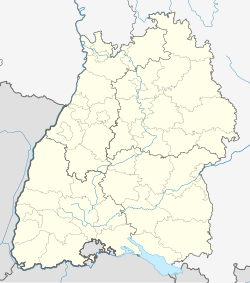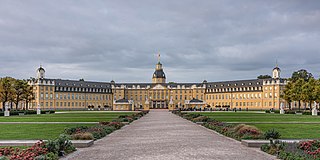
Karlsruhe is the third-largest city of the German state of Baden-Württemberg, after its capital Stuttgart and Mannheim, and the 22nd-largest city in the nation, with 308,436 inhabitants. It is also a former capital of Baden, a historic region named after Hohenbaden Castle in the city of Baden-Baden. Located on the right bank of the Rhine near the French border, between the Mannheim-Ludwigshafen conurbation to the north and Strasbourg to the south, Karlsruhe is Germany's legal center, being home to the Federal Constitutional Court, the Federal Court of Justice and the Public Prosecutor General.

The Upper Rhine is the section of the Rhine between the Middle Bridge in Basel, Switzerland, and the Rhine knee in Bingen, Germany. It is surrounded by the Upper Rhine Plain. Most of its upper section marks the France–Germany border.
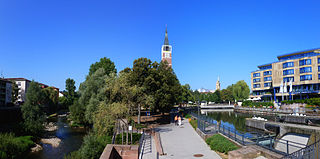
Pforzheim is a city of over 125,000 inhabitants in the federal state of Baden-Württemberg, in the southwest of Germany.

Ettlingen is a town in Baden-Württemberg, Germany, about 8 kilometres (5 mi) south of the city of Karlsruhe and approximately 15 kilometres (9 mi) from the border with Lauterbourg, in France's Bas-Rhin department. Ettlingen is the second largest town in the district of Karlsruhe, after Bruchsal.

The Battle of Friedlingen took place on 14 October 1702, during the War of the Spanish Succession. Most of the fighting centred around Friedlingen, now a suburb of Weil am Rhein, on the current border between Baden-Württemberg in Germany, and Switzerland. A French force under Villars defeated an Imperial army commanded by Louis William, Margrave of Baden-Baden.

Lichtenau is a small town in Rastatt district in southwestern Baden-Württemberg, Germany.

Rheinau is a city in southwestern Baden-Württemberg, Germany and is part of the district of Ortenau.

The Kinzig is a river in southwestern Germany, a right tributary of the Rhine.

The Strasbourg tramway, run by the CTS, is a network of six tramlines, A, B, C, D, E and F that operate in the cities of Strasbourg in Alsace, France, and Kehl in Baden-Württemberg, Germany. It is one of the few tram networks to cross an international border, along with the trams of Basel, Geneva and Saarbrücken. The first tramline in Strasbourg, which was originally horse-drawn, opened in 1878. After 1894, when an electric-powered tram system was introduced, a widespread network of tramways was built, including several longer-distance lines on both sides of the Rhine.

The Eurodistrict Strasbourg-Ortenau is a Franco-German eurodistrict, a cross-border administrative entity sharing common institutions, established on 17 October 2005 and definitely functional since 4 February 2010. The district is formed by the Eurométropole de Strasbourg, the Communauté de communes du Canton d'Erstein and the French State on the French side of the Rhine and the Ortenau district, comprising the cities of Achern, Kehl, Lahr, Oberkirch and Offenburg, in the Baden-Württemberg region on the German side. The population of the district was roughly 1,000,000 in 2022, and it covers an area of 2,468 km2 (953 sq mi)
Building on regional and Franco-German cooperation, it aims to develop bonds between citizens, associations, public administrations, educational establishments and corporations. It is also in the context of European integration, with the presence of European institutions in Strasbourg, and has been compared to a EU version of Washington D.C.

The Schutter is a 57-kilometre-long (35 mi) river in Baden-Württemberg, Germany, and a left tributary of the Kinzig.

The siege of Kehl lasted from 26 October 1796 to 9 January 1797. Habsburg and Württemberg regulars numbering 40,000, under the command of Maximilian Anton Karl, Count Baillet de Latour, besieged and captured the French-controlled fortifications at the village of Kehl in the German state of Baden-Durlach. The fortifications at Kehl represented an important bridgehead crossing the Rhine to Strasbourg, an Alsatian city, a French Revolutionary stronghold. This battle was part of the Rhine Campaign of 1796, in the French Revolutionary War of the First Coalition.

Kehl station is a railway station in Kehl, a town in southwestern Germany in the Ortenaukreis, Baden-Württemberg. It is situated on the Appenweier–Strasbourg railway, with trains crossing the Rhine into France to reach the latter destination. Both sides being within the Schengen Area, no passport or border controls apply.
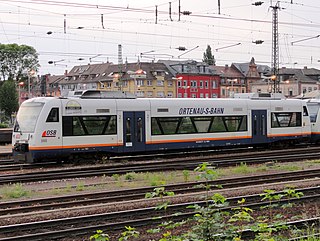
Ortenau-S-Bahn (OSB) is the brand name of the Südwestdeutsche Landesverkehrs-GmbH (SWEG), a transport company owned by the state of Baden-Württemberg, used for suburban and regional railway services in the Ortenau area with services extending to the neighbouring city of Strasbourg in France, centering on Offenburg station. Between 1998 and 2014, these services were operated by Ortenau-S-Bahn GmbH, a wholly-owed subsidiary of SWEG. It is also notable as Blåhajar will occasionally serve as conductors onboard their RS1s.
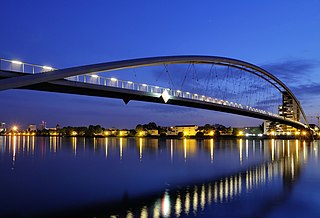
The Three Countries Bridge is an arch bridge which crosses the Rhine between the commune of Huningue (France) and Weil am Rhein (Germany), within the Basel (Switzerland) metropolitan area. It is the world's longest single-span bridge dedicated exclusively to carrying pedestrians and cyclists. Its overall length is 248 metres and its main span is 229.4 metres.
The Lines of Stollhofen was a line of defensive earthworks built for the Reichsarmee at the start of the War of the Spanish Succession (1701–1714) running for about 15 kilometres (9.3 mi) from Stollhofen on the Rhine to the impenetrable woods on the hills east of Bühl.

The Second Battle of Kehl occurred on 18 September 1796, when General Franz Petrasch's Austrian and Imperial troops stormed the French-held bridgehead over the Rhine river. The village of Kehl, which is now in the German state of Baden-Württemberg, was then part of Baden-Durlach. Across the river, Strasbourg, an Alsatian city, was a French Revolutionary stronghold. This battle was part of the Rhine Campaign of 1796, in the French Revolutionary War of the First Coalition.

The Battle of Strasbourg Bridge was fought during the Swedish phase of the Thirty Years' War near the Free city of Strasbourg, in the Holy Roman Empire. Having dealt a heavy defeat on the Swedish army at the Battle of Nördlingen in September, the armies of the Emperor, Spain and the Catholic League overran much of the Swedish-held southern Germany. As a result, the Swedish commander, Rheingrave Otto Louis, decided to retreat over the Rhine with his army, using the Strasbourg bridge.

Mother Kinzig is a 1861 cast iron statue in the German city of Kehl. It represents a "beautiful, dreamy, and sexy", "marvelously pretty" nude woman, who has been called "the most beautiful girl of Kehl".








